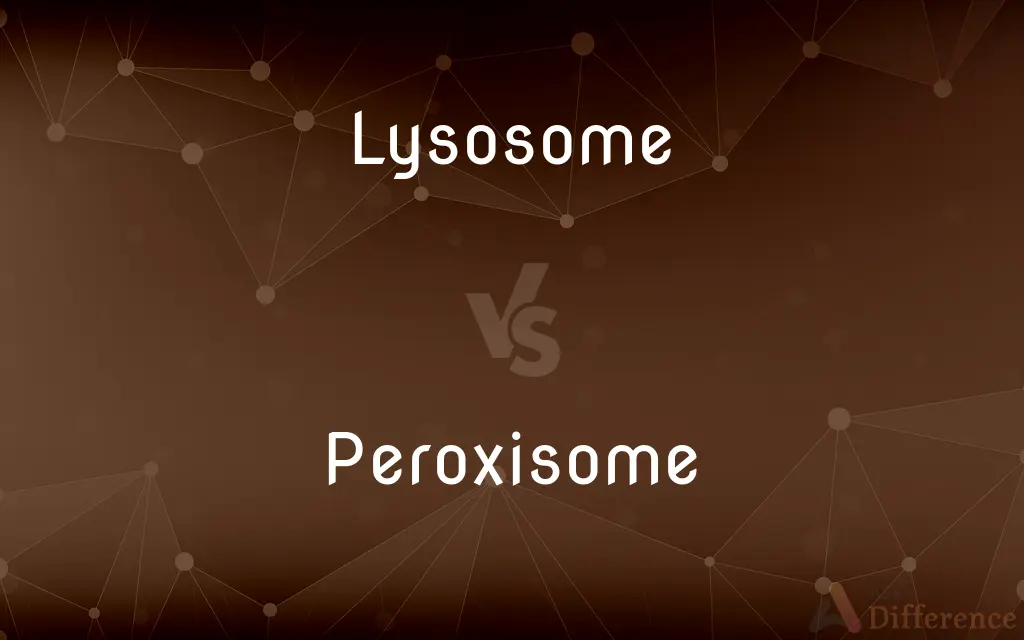Lysosome vs. Peroxisome — What's the Difference?
Edited by Tayyaba Rehman — By Maham Liaqat — Updated on March 14, 2024
Lysosomes are cell organelles that digest waste, whereas peroxisomes detoxify harmful substances.

Difference Between Lysosome and Peroxisome
Table of Contents
ADVERTISEMENT
Key Differences
Lysosomes, known as the cell's waste disposal system, contain enzymes to break down biomolecules and cellular debris. Peroxisomes, on the other hand, are involved in lipid metabolism and the detoxification of harmful substances, such as hydrogen peroxide, through specific enzymes like catalase.
While lysosomes originate from the Golgi apparatus and endosomes, peroxisomes are formed by the division of existing peroxisomes and can also arise from the endoplasmic reticulum. This difference in origin highlights the distinct pathways and mechanisms through which these organelles are maintained and function within the cell.
Lysosomes play a key role in autophagy, the process by which cells recycle their own components, contributing to cellular homeostasis and renewal. Peroxisomes, however, are crucial for the breakdown of very long-chain fatty acids through beta-oxidation, a process not performed by lysosomes.
The internal environment of lysosomes is acidic, which is essential for the optimal activity of their hydrolytic enzymes. In contrast, peroxisomes maintain a neutral pH, suitable for the enzymes involved in oxidative reactions and the conversion of harmful reactive oxygen species into safer molecules.
Lysosomal malfunction can lead to lysosomal storage diseases, characterized by the accumulation of undigested substrates within the cell. Peroxisomal disorders, such as Zellweger syndrome, arise from defects in peroxisome biogenesis or function, leading to a wide range of metabolic abnormalities.
ADVERTISEMENT
Comparison Chart
Function
Digests waste and biomolecules
Detoxifies substances, lipid metabolism
Origin
Golgi apparatus and endosomes
Division of existing peroxisomes, ER
Role in cell
Autophagy, cellular waste disposal
Beta-oxidation, ROS detoxification
Internal environment
Acidic
Neutral
Associated disorders
Lysosomal storage diseases
Peroxisomal disorders (e.g., Zellweger syndrome)
Compare with Definitions
Lysosome
Waste disposal.
Lysosomes break down cellular debris for recycling.
Peroxisome
Beta-oxidation.
Peroxisomes are involved in the breakdown of long-chain fatty acids.
Lysosome
Linked to storage diseases.
Lysosomal malfunction can lead to lysosomal storage diseases.
Peroxisome
Arises from ER.
Peroxisomes can form from the endoplasmic reticulum.
Lysosome
Autophagy involvement.
Lysosomes play a crucial role in autophagy, cleaning up the cell.
Peroxisome
Detoxification.
Peroxisomes detoxify hydrogen peroxide into water.
Lysosome
Acidic environment.
The acidic pH inside lysosomes activates digestive enzymes.
Peroxisome
Neutral pH.
The internal environment of peroxisomes is neutral.
Lysosome
Originates from Golgi.
Lysosomes are formed from the Golgi apparatus.
Peroxisome
Peroxisomal disorders.
Defects in peroxisomes can lead to disorders like Zellweger syndrome.
Lysosome
A lysosome () is a membrane-bound organelle found in many animal cells. They are spherical vesicles that contain hydrolytic enzymes that can break down many kinds of biomolecules.
Peroxisome
A cell organelle containing a large number of enzymes, including catalase and oxidase, that break down long-chain fatty acids and other organic molecules. The hydrogen peroxide produced by these reactions is also broken down within the peroxisome.
Lysosome
A membrane-bound organelle in the cytoplasm of most cells containing various hydrolytic enzymes that function in intracellular digestion.
Peroxisome
A peroxisome (IPA: [pɛɜˈɹɒksɪˌsoʊm]) is a membrane-bound organelle (formerly known as a microbody), found in the cytoplasm of virtually all eukaryotic cells. Peroxisomes are oxidative organelles.
Lysosome
(cytology) An organelle found in all types of animal cells which contains a large range of digestive enzymes capable of splitting most biological macromolecules.
Peroxisome
(cytology) An intracellular organelle found in all eukaryotes (except Archezoa) which is the source of the enzymes that catalyze the production and breakdown hydrogen peroxide, and are responsible for the oxidation of long-chain fatty acids.
Lysosome
An organelle found in the cytoplasm of most cells (especially in leukocytes and liver and kidney cells)
Common Curiosities
What process are peroxisomes involved in that lysosomes are not?
Peroxisomes are involved in beta-oxidation of very long-chain fatty acids.
Where do lysosomes originate from?
Lysosomes originate from the Golgi apparatus and endosomes.
How do peroxisomes contribute to cell metabolism?
Peroxisomes detoxify harmful substances and participate in lipid metabolism.
What is a peroxisomal disorder?
Peroxisomal disorders are genetic conditions affecting peroxisome function, like Zellweger syndrome.
What is the main function of lysosomes?
Lysosomes digest cellular waste and biomolecules.
Can lysosomes and peroxisomes interchange their functions?
No, lysosomes and peroxisomes have distinct functions and cannot interchange them.
What can result from lysosomal malfunction?
Lysosomal malfunction can lead to lysosomal storage diseases.
Why is the internal environment of lysosomes acidic?
The acidic environment activates the digestive enzymes within lysosomes.
How do peroxisomes detoxify harmful substances?
Peroxisomes use enzymes like catalase to convert harmful substances into less toxic ones.
How do cells maintain the acidic environment inside lysosomes?
Cells use proton pumps to maintain the acidic pH inside lysosomes.
Can peroxisomal functions be performed by other organelles if peroxisomes are defective?
Some peroxisomal functions can be partially compensated by other organelles, but not all.
How are new peroxisomes formed within the cell?
New peroxisomes are formed by the division of existing peroxisomes and from the endoplasmic reticulum.
What role do peroxisomes play in oxidative stress?
Peroxisomes reduce oxidative stress by breaking down reactive oxygen species.
What are the consequences of defective lysosomal enzymes?
Defective lysosomal enzymes lead to the accumulation of undigested substrates, causing diseases.
Are lysosomes involved in any processes besides waste disposal?
Yes, lysosomes are also involved in processes like autophagy.
Share Your Discovery

Previous Comparison
Producer vs. Consumer
Next Comparison
Series vs. SequenceAuthor Spotlight
Written by
Maham LiaqatEdited by
Tayyaba RehmanTayyaba Rehman is a distinguished writer, currently serving as a primary contributor to askdifference.com. As a researcher in semantics and etymology, Tayyaba's passion for the complexity of languages and their distinctions has found a perfect home on the platform. Tayyaba delves into the intricacies of language, distinguishing between commonly confused words and phrases, thereby providing clarity for readers worldwide.
















































